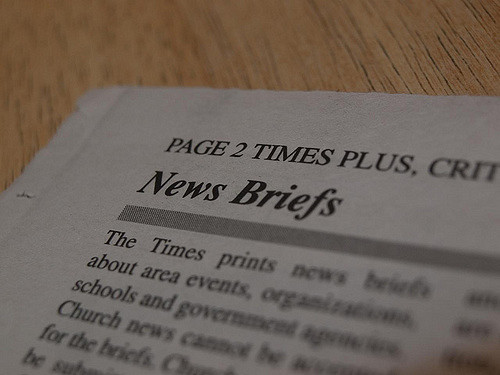On a daily if not hourly basis, we are bombarded by breaking news. The proliferation of news channels and social media increases the volume and speed of how news spreads. Given turbulent news, instructors can leverage current events to demonstrate the applicability of course content. In my book, Teaching for Learning: 101 Intentionally Designed Educational Activities to Put Students on the Path to Success, my co-authors and I described how faculty can accomplish the goal of teaching with the news. In today’s post, I want to share our In the News IDEA so help instructors think about how they can use current events in the classroom.

IDEA #16: In the News
Overview
It has long been known that students are more likely to learn and to retain information for which they see practical use and relevance (Dewey, 1938). The In the News IDEA can be used in a variety of different formats and course subjects to illustrate to students that concepts learned in class are directly relevant to societal issues. Students may bring in news stories of their choice to discuss, or the instructor may select a “hot topic” for the class. The core concept is to cold-call on students to describe their news story or share thoughts about a current event to encourage class discussion and application of course content to contemporary contexts. In the News is particularly engaging when controversial topics are brought to class that provide fodder for discussion.
Discussion of current events fosters critical thinking and analytic skills. Students enter class with a variety of social, political, and religious perspectives. Encouraging productive discussion on contemporary events can help students consider their own opinion as well as differing views held by their classmates (Borg & Borg, 2001).
Guiding Principles
As part of their college education, students undergo intellectual development that helps them think critically and develop their own perspectives of the world (Belenky, Clinchy, Goldberger, & Tarule, 1986; Perry, 1970). In order to encourage students to develop more complex thinking, instructors should appropriately challenge students. Students may not initially be ready to engage in thinking that questions their initial assumptions. However, In the News can be used as a vehicle to create a class structure and environment that challenges and supports students through the intellectual growth process.
In today’s information- and media rich environment, students receive news and information from a variety of sources. Many of these sources include a range of editorial comment and direction. Conrad and Dunek (2012) suggest that students need the ability to challenge these sources and trust their own analytic ability to achieve success in such an environment. In their view, the goal of higher education is to create inquiry-driven learners who cultivate the learning process rather than gaining a specific body of knowledge. In the News provides a way to guide students in this process by helping to identify bias, evaluate claims, and draw conclusions for themselves.
Preparation
Prior to using In the News, consider the potential controversy of the topic to be discussed. Determining a set of ground rules is helpful to maintaining an appropriate classroom environment for any discussion-based activity. It is also helpful to come up with a plan for leading the discussion. When students have brought in a relevant news story, you can cold-call on individual students to describe their stories. Also consider plans for how to encourage reticent students to participate and identity questions that emphasize a particular view rather than an individual. Using phrases such as “critics suggest” or “proponents argue” can reduce comments directed toward individuals. It is also helpful to decide before class if your own personal opinions will be shared or withheld during or following the discussion. Depending on the course or topic to be discussed and your overall goals of the activity, determine ahead of time whether students will bring in news tories of their own choosing or you will select the topic.
Process
- Prepare readings on a current event prior to class or have students bring in news stories.
- If the topic is controversial, discuss ground rules for establishing a supportive environment for discussion prior to the discussion commencing.
- Cold-call on students to discuss their news stories or the day’s current event. You may facilitate the discussion or allow students to engage directly with each other.
- To conclude the discussion, summarize the relevant viewpoints and encourage students to consider the views of the news source.
Sample IDEA Pairings
Snowball (IDEA #2). Students gather in progressively larger groups, discussing the major ideas and implications of their respective news stories.
Timeline (IDEA #81). Students create a Timeline that illustrates the major events, people, and themes related to their news story. This activity ensures preparation in advance of the class discussion.
Post Hoc Analysis (IDEA #100). After the In the News discussion, students reflect on their news stories by looking for larger patterns and trends that may not have been evident prior to the class discussion.
Pro-tips
When discussing current events, some students may be eager to share their views and process the issues quickly. Other students may prefer not to participate. To encourage equal participation, set up ground rules or a structure that helps enable everyone to engage in the discussion.
Through verbal and physical cues, you can help keep a discussion of a controversial current event from getting out of hand. By moving around the class or providing supportive comments, you can facilitate the discussion and maintain a positive classroom climate.
Particularly if a significant majority of the class feel similarly about an issue, you may wish to play the role of devil’s advocate. By supporting the weaker side or even the weaker argument, you illustrate how to support an argument and expose weaknesses in the other side (Payne & Gainey, 2000).

